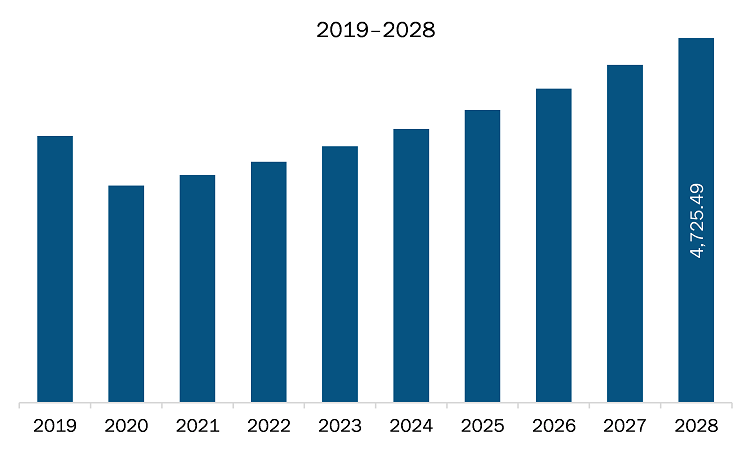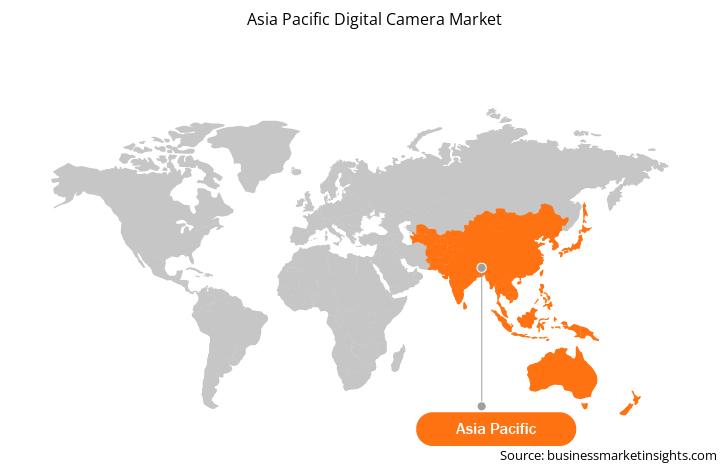The digital camera market in APAC is further segmented into China, India, Japan, South Korea, Australia, and the Rest of APAC. The continuously growing regional economy is reflecting in increasing disposable income of individuals, which supports sales of high-end products, including DSLR cameras. Besides, the use of such gadgets is further on rise due to improving internet infrastructure in Asian countries. Youth hold a significant share of the total population in APAC, which can be directly proportional to the adoption of technologically advanced and innovative devices. They are interested in making vlogs, documentary films, and short movies; many of them are aspiring to become professional photographers. Digital camera manufacturers have tremendous opportunities to boost their revenue by meeting the emerging requirements of the tech-savvy youth in this region. Furthermore, the booming event management segment, which requires live streaming and better video quality in real time, as well as notably growing trend of prewedding shoots are generating huge demands for high-end cameras. Further, the popularity of Indian movies is crossing the national borders, which is encouraging filmmakers to come up with scripts for a diverse range of genres, including romance, thriller, sci-fi, and action. All the aforementioned factors are driving the digital camera market growth across the region.
The COVID-19 is anticipated to cause a significant economic loss in the Asia Pacific region. The consequence and impact can be even worse and totally depends on the spread of the virus. The governments of various Asia Pacific countries are taking possible steps to restrict the spread of the virus by announcing lockdown, which in turn has negatively impacted the revenue generated by the digital camera market. The ongoing COVID-19 is anticipated to cause huge disruptions in the growth of various industries of Asia Pacific region. For instance, China is the global manufacturing hub for various industries and the largest raw material supplier. However, after a strict two-month lockdown especially in Wuhan area, China is now relaxing restrictions as the number of new cases have dropped drastically in past month (<10 cases/ day) and factories have started with preventive measures in place, especially in the crucial consumer electronics sector. However, the uncertainty regarding the future outbreak especially in countries such as India and few other Asian countries, where the graph is going upwards may affect the growth of digital camera market in coming quarters. The disruptions in the demand for tourism activities, film shootings, and other type of gatherings have been impacted due to social distancing norms and restrictions may further affect the demand in Asian countries

Strategic insights for the Asia Pacific Digital Camera provides data-driven analysis of the industry landscape, including current trends, key players, and regional nuances. These insights offer actionable recommendations, enabling readers to differentiate themselves from competitors by identifying untapped segments or developing unique value propositions. Leveraging data analytics, these insights help industry players anticipate the market shifts, whether investors, manufacturers, or other stakeholders. A future-oriented perspective is essential, helping stakeholders anticipate market shifts and position themselves for long-term success in this dynamic region. Ultimately, effective strategic insights empower readers to make informed decisions that drive profitability and achieve their business objectives within the market.

| Report Attribute | Details |
|---|---|
| Market size in 2021 | US$ 2,950.78 Million |
| Market Size by 2028 | US$ 4,725.49 Million |
| Global CAGR (2021 - 2028) | 7.0% |
| Historical Data | 2019-2020 |
| Forecast period | 2022-2028 |
| Segments Covered |
By Type
|
| Regions and Countries Covered | Asia-Pacific
|
| Market leaders and key company profiles |
The geographic scope of the Asia Pacific Digital Camera refers to the specific areas in which a business operates and competes. Understanding local distinctions, such as diverse consumer preferences (e.g., demand for specific plug types or battery backup durations), varying economic conditions, and regulatory environments, is crucial for tailoring strategies to specific markets. Businesses can expand their reach by identifying underserved areas or adapting their offerings to meet local demands. A clear market focus allows for more effective resource allocation, targeted marketing campaigns, and better positioning against local competitors, ultimately driving growth in those targeted areas.

The digital camera market in APAC is expected to grow from US$ 2,950.78 million in 2021 to US$ 4,725.49 million by 2028; it is estimated to grow at a CAGR of 7.0% from 2021 to 2028. Growing demand for mirrorless cameras; A mirrorless system camera does not involve a mirror box within its body and are designed with a compact and attractive exterior with an electronic viewfinder paired with interchangeable lens. Such cameras offer convenience in use compared to digital SLR cameras owing to their smaller and lighter structure. Mirrorless camera comprises lens at the front body along with sensor placed inside and a screen along with an optional viewfinder placed at the back. Additionally, such cameras have small, short, and light lenses and are constructed with a tiny LED or OLED screen, which helps to deliver best possible results altogether. Despite their smaller size, such cameras are designed to provide high quality images with outstanding clarity as that of other conventional digital cameras. The limited presence of glass elements within lenses allows quick autofocus. Further, mirrorless cameras are generally composed of APS-C sensor or a Micro Four Thirds sensor, which offers portability and convenience over DSLRs. With the rising adoption of mirrorless cameras, there is increase in variety of lenses and their respective configurations. Such cameras are extensively demanded from budding photographers to various professional photographers owing to compact and sleekier mirrorless designs along with limited noise making. This is bolstering the growth of the digital camera market.
In terms of type, the mirrorless segment accounted for the largest share of the APAC digital camera market in 2020. In terms of end user type, the professional
A few major primary and secondary sources referred to for preparing this report on the digital camera market in APAC are company websites, annual reports, financial reports, national government documents, and statistical database, among others. Major companies listed in the report are Canon Inc
The Asia Pacific Digital Camera Market is valued at US$ 2,950.78 Million in 2021, it is projected to reach US$ 4,725.49 Million by 2028.
As per our report Asia Pacific Digital Camera Market, the market size is valued at US$ 2,950.78 Million in 2021, projecting it to reach US$ 4,725.49 Million by 2028. This translates to a CAGR of approximately 7.0% during the forecast period.
The Asia Pacific Digital Camera Market report typically cover these key segments-
The historic period, base year, and forecast period can vary slightly depending on the specific market research report. However, for the Asia Pacific Digital Camera Market report:
The Asia Pacific Digital Camera Market is populated by several key players, each contributing to its growth and innovation. Some of the major players include:
The Asia Pacific Digital Camera Market report is valuable for diverse stakeholders, including:
Essentially, anyone involved in or considering involvement in the Asia Pacific Digital Camera Market value chain can benefit from the information contained in a comprehensive market report.